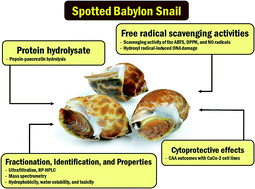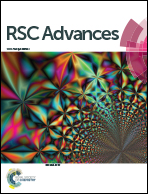The antioxidant potential of peptides obtained from the spotted babylon snail (Babylonia areolata) in treating human colon adenocarcinoma (Caco-2) cells
Abstract
This research study investigated the free radical-scavenging activities of peptides which were obtained from the protein hydrolysates of the spotted babylon snail using a combination of pepsin and pancreatin proteolysis which can replicate the conditions of gastrointestinal digestion. In this study, spotted babylon protein hydrolysate (SPH) derived from a sequential 3 hour digestion, first with pepsin and then with pancreatin, was examined. SPH was fractionated using molecular weight cut-off membranes for 10 kDa, 5 kDa, 3 kDa, and 0.65 kDa. It was found that the MW < 0.65 kDa fraction provided the greatest levels of 2,2′-azino-bis-3-ethylbenzothiazoline-6-sulphonic acid (ABTS), 2,2-diphenyl-1-picrylhydrazl (DPPH), and nitric oxide (NO) radical scavenging activity. Three subfractions of the MW < 0.65 kDa fraction were then generated via RP-HPLC. The subfraction which subsequently demonstrated the greatest free radical scavenging activity was F3, which was accordingly chosen for further investigation commencing with quadrupole-time-of-flight-electron spin induction-mass spectrometry-based de novo peptide sequencing. This resulted in the identification of a pair of novel peptides: His–Thr–Tyr–His–Glu–Val–Thr–Lys–His (HTYHEVTKH), and Trp–Pro–Val–Leu–Ala–Tyr–His–Phe–Thr (WPVLAYHF). The WPVLAYHF peptide exhibited greater antioxidant activity. The study also confirmed that the F3 sub-fraction was able to prevent hydroxyl radicals from causing DNA damage by conducting tests which involved the pKS, pUC19, and pBR322 plasmids using the Fenton reaction. In addition, cellular antioxidant activity was demonstrated by two synthetic peptides toward the human adenocarcinoma colon (Caco-2) cell line, with the potency of the activity dependent upon the peptide concentration.



 Please wait while we load your content...
Please wait while we load your content...